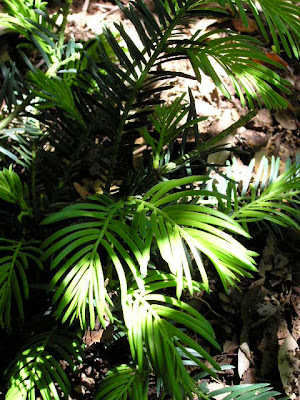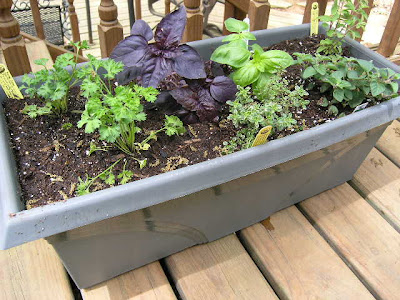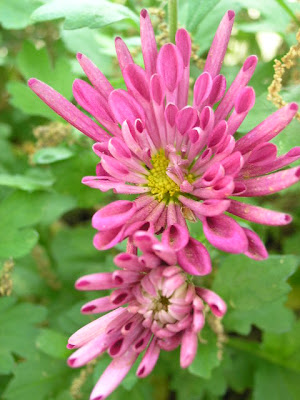Earlier in the week, I realized that my presence was agitating a hummingbird in the tree above me. After a few minutes of observation, I discovered that the little female was building a nest. She'd zip in with a tiny piece of white fluff held in the tip of her bill, land on the nest, do some quick actions, then buzz away again. The picture isn't sharp, but that's her sitting in the nest in the center of the photo. This is the first hummingbird nest I've ever discovered in the yard.
Back to its original location from last year, I planted one of the cuttings I made from the Beefsteak Plant (Perilla 'Magilla') in one of the front yard beds. It did quit nicely there previously, growing to almost four foot. Here's hoping I get the same results this year (and I've still got more cuttings to try elsewhere).
Finally changed the status of my two Mexican Turk's Cap (Malvaviscus arboreus var. mexicanus) from dormant to dead. Same is also true of a few plants that were transplanted right before the big freezes hit: Coral Nymph Sage (Salvia coccinea 'Coral Nymph'), Smooth-Leaf Sage (Salvia miniata) & Pink Dianthera (Dianthera candicans). I guess the winter's 18 degrees was just too low or too soon.
So in to some of these vacant spots (plus some that were empty to begin with), I did some planting. A Giant Spiderwort (Tradescantia gigantea), already looking wilted, went behind some Liriope. Three Red Columbine (Aquilegia canadensis) and three Lyreleaf Sage (Salvia lyrata) went into the backyard beds. Have tried both with limited to no success in the past, but it appears the time has come for another attempt.
Been on the lookout for Husker's Red Penstemon (Penstemon digitalis 'Husker's Red'), and I finally captured this elusive quarry. Really like the red coloration in the leaves, and I'm hopeful that it will bloom as well my other penstemons.
In a deeply shady section, where it can cascade over some railroad ties, I'm trying the Spreading Plum Yew (Cephalotaxus harringtonia 'Prostrata'). It is supposed to do well even in significant shade, so I'm interested to see how it does for me. The picture was taken during the sunniest part of the day for this spot: it gets maybe 1-2 hours of dappled light and then no direct sun the remainder of the time.
To fill in the holes made by the deceased Mexican Turk's Caps, I'm trying two plants that are new to my shady garden: Goldmound Spirea (Spiraea japonica 'Goldmound') & White Margin Snow Rose (Serissa foetida 'Improved').
The Goldmound Spirea is covered in chartreuse foliage which really stands out in the dappled shade. It presently has several unopened buds destined to be clusters of tiny light pink flowers. Wouldn't be surprised if this is the only year it blooms, but I'm mainly interested in those neon leaves anyway (though I certainly wouldn't turn away any returning blooms!).
I was completely unfamiliar with White Margin Snow Rose, so this was a nice discovery. The small variegated leaves are joined by occasional tiny white blossoms. But, again, its the foliage that steals the show.
Beautiful weekend to be in the garden...
Sunday, April 25, 2010
Wednesday, April 21, 2010
Cedar Sages Take a Bow (Sadly)
My garden's three Cedar Sages (Salvia roemeriana) came back strong this year, rising up from the ground and then throwing out stalks of brilliant red flowers beside the backyard path.
Then came last week's rains. And the Cedar Sages took an unfortunate bow.
I believe the same thing happened last year. Does this happen to your Cedar Sages?
There must be a trick to keeping them upright. I guess I need to be more proactive. Perhaps some type of bloom stakes or grow-through supports? Maybe etiquette lessons on proper posture?
And what to do post-collapse? Enjoy the brilliant, though vertically challenged, flowers? Snip them off and transfer them to a vase? I assume snipping will encourage additional blooms.
I guess I'll look at this as an opportunity to bring some fresh cut flowers inside the house...
Then came last week's rains. And the Cedar Sages took an unfortunate bow.
I believe the same thing happened last year. Does this happen to your Cedar Sages?
There must be a trick to keeping them upright. I guess I need to be more proactive. Perhaps some type of bloom stakes or grow-through supports? Maybe etiquette lessons on proper posture?
And what to do post-collapse? Enjoy the brilliant, though vertically challenged, flowers? Snip them off and transfer them to a vase? I assume snipping will encourage additional blooms.
I guess I'll look at this as an opportunity to bring some fresh cut flowers inside the house...
Tuesday, April 20, 2010
Recently...
Have been somewhat amiss on keeping up with the small happenings in the garden. So I decided to group some of the events that have occurred over the last ten days into this single posting.
About a week ago, another variety of mushrooms made a surprise appearance. I especially liked the ribbed view from above. As with almost all of these fungi, they disappeared back into the soil within a couple of days.
The Chickadee brood has been keeping the parents busy. While working in the garden, I have gotten to watch the parents flying in & out, making sure the youngsters stay well fed. But all appeared quiet today, and upon checking, it looks as if the nestlings have departed.
Me & the missus are delving into new territory by creating a small herb garden (parsley, basil, oregano & thyme). Not sure if we have sufficient light, but I can at least move the plants around on the deck in an attempt to locate an optimum spot.
Recent rains seems to have brought out the critters - both beneficial and no so beneficial.
The Sweet Kate Spiderwort (Tradescantia x andersoniana 'Sweet Kate') has been sending its lime green shoots ever higher. The bright coloration lasts until the summer heat sets, then slowly darkens. No blooms yet.
But a couple of other plants are producing their first blooms of the year for my shady garden.
I also finally got around to potting the Golden Tooth Aloe (Aloe perfoliata) that I got at the recent Cactus & Succulent Show. Included in the pot is a low growing Sedum (variety unknown).
Then I decided to get experimental and created the first hanging basket of my garden using the Ghost Plant (Graptopetalum paraguayense). I was inspired to try this by a couple of postings: Tough Decisions on Rock Rose and Hanging Succulent Gardens on Danger Garden (be sure to check them out!). Looks a little empty now, but I have faith (for now).
Been a busy time. It's good to get caught up with the recent happenings.
About a week ago, another variety of mushrooms made a surprise appearance. I especially liked the ribbed view from above. As with almost all of these fungi, they disappeared back into the soil within a couple of days.
The Chickadee brood has been keeping the parents busy. While working in the garden, I have gotten to watch the parents flying in & out, making sure the youngsters stay well fed. But all appeared quiet today, and upon checking, it looks as if the nestlings have departed.
Me & the missus are delving into new territory by creating a small herb garden (parsley, basil, oregano & thyme). Not sure if we have sufficient light, but I can at least move the plants around on the deck in an attempt to locate an optimum spot.
Recent rains seems to have brought out the critters - both beneficial and no so beneficial.
The Sweet Kate Spiderwort (Tradescantia x andersoniana 'Sweet Kate') has been sending its lime green shoots ever higher. The bright coloration lasts until the summer heat sets, then slowly darkens. No blooms yet.
But a couple of other plants are producing their first blooms of the year for my shady garden.
Jerusalem Sage
Lenten Rose
I also finally got around to potting the Golden Tooth Aloe (Aloe perfoliata) that I got at the recent Cactus & Succulent Show. Included in the pot is a low growing Sedum (variety unknown).
Then I decided to get experimental and created the first hanging basket of my garden using the Ghost Plant (Graptopetalum paraguayense). I was inspired to try this by a couple of postings: Tough Decisions on Rock Rose and Hanging Succulent Gardens on Danger Garden (be sure to check them out!). Looks a little empty now, but I have faith (for now).
Been a busy time. It's good to get caught up with the recent happenings.
Green World
Each month, Gardening Gone Wild sponsors the "Picture This" photo contest with April's theme being "Green World". Numerous outstanding entries can be viewed at the site & I highly recommend that you check it out. My entry for this month was inspired by the annual renewal of the ferns; their numerous bright green fronds unfurling outward.
Sunday, April 18, 2010
Strawberry Begonia/Geranium
Strawberry Begonia or Strawberry Geranium (Saxifraga stolonifera): I must not be able to make up my mind which name to use because I swap back & forth from moment to moment. Some of my recent postings included pictures of its diminutive asymmetrical blossom, and that seems to have sparked some interest.
The individual blossom is slightly smaller than a dime, so you have to lean close to see the delicate intricacies and pink highlights of the flower. Several flower stalks, each supporting ten or more blooms, rise above the variegated foliage, creating a hovering cloud of white.
Several of the stalk's blossoms will open simultaneously, and more will continue to open over time. The blooms last several days, so the show is likely to last nearly a month.
Growing in filtered shade, the blossoms are not its only attribute. Even when not in bloom, the 3 inch tall mat of variegated foliage is quite eye-catching. It has slowly spread outward from the planting site; the three original plants have about doubled their coverage in a year.
The evergreen leaves made it through our recent 18 degree winter without protection. The plant did seem to "shrink" some during the winter, though I did not witness any damage to the plant. Perhaps leaf litter simply buried some of them.
Leaves that have been accidentally broken off, can easily be rooted by simply placing them in to moist potting soil. I have transferred a couple of transplants created in this manner to a much shadier area (under a thick boxwood), and though a little early to tell, they seem to be doing well.
For gardeners looking for something a little different in their shady spot, you might consider the Strawberry Begonia. Or maybe even the Strawberry Geranium.
The individual blossom is slightly smaller than a dime, so you have to lean close to see the delicate intricacies and pink highlights of the flower. Several flower stalks, each supporting ten or more blooms, rise above the variegated foliage, creating a hovering cloud of white.
Several of the stalk's blossoms will open simultaneously, and more will continue to open over time. The blooms last several days, so the show is likely to last nearly a month.
Growing in filtered shade, the blossoms are not its only attribute. Even when not in bloom, the 3 inch tall mat of variegated foliage is quite eye-catching. It has slowly spread outward from the planting site; the three original plants have about doubled their coverage in a year.
The evergreen leaves made it through our recent 18 degree winter without protection. The plant did seem to "shrink" some during the winter, though I did not witness any damage to the plant. Perhaps leaf litter simply buried some of them.
Leaves that have been accidentally broken off, can easily be rooted by simply placing them in to moist potting soil. I have transferred a couple of transplants created in this manner to a much shadier area (under a thick boxwood), and though a little early to tell, they seem to be doing well.
For gardeners looking for something a little different in their shady spot, you might consider the Strawberry Begonia. Or maybe even the Strawberry Geranium.
Friday, April 16, 2010
Foliage Follow-Up: April 2010
Now that we've celebrated my shady blossoms, its time to turn our attention to the foliage.
I have slowly learned that a shady garden is really a leafy garden. I often give in to blossom envy; purchasing plants that, fresh from the nursery, bloom that first year, but only feebly thereafter. Thus my garden has shown me that I'd better pay attention to plants that are grown predominately for their foliage.
Here are a few that were selected with that specifically in mind:
Variegated Shell Ginger
I have slowly learned that a shady garden is really a leafy garden. I often give in to blossom envy; purchasing plants that, fresh from the nursery, bloom that first year, but only feebly thereafter. Thus my garden has shown me that I'd better pay attention to plants that are grown predominately for their foliage.
Here are a few that were selected with that specifically in mind:
Red Dragon Knotweed
Frozen to the ground this past winter, it is coming back strong. Initial growth from the ground was burgundy, but with warmer temperatures it has developed into its typical red/green pattern. Forms a mound about 3 foot tall & wide. Late in the season last year, it even produced scattered clusters of tiny white blossoms. It seems pretty easy to grow from cuttings.
Variegated Shell Ginger
Originally planted in the ground, the winter freezes kept seriously setting the plant back. So I eventually moved it into a pot so that I could protect it from the low temperatures. I've heard that it can bloom, but mine never has.
Gold Dust Plant
This evergreen shrub has a very nice impact in the shade garden. Seems to like filtered light, but will even grow in those shadier portions of the yard. Can be grown from cuttings, but grows so slowly I'm not sure if it is worth it.
This plant was my very first Hosta, and I've never been disappointed in it. Though it has never bloomed for me, each year it has come back thicker and larger. I enjoy the ribbed leaves with their darker green edges. It tends to lift the leaves up high which reduces slug & pillbug damage.
Purple Shamrock
Always nice to introduce leaves to the shade garden that break through the green barrier. Though dark leaves tend to disappear into the shade, these tend to look nice when planted near light green vegetation. And it's pale pink blossoms show up well against the purple.
Recommended for shade by a guest on Central Texas Gardener, my single plant has produced pups that have led to my now having four good sized Manfredas. They are also rumored to do well in the sun (though I have no personal experience with that!). Unprotected, it shrugged off this winter's 18 degree lows with no damage at all. Early in the spring, as the sunshine reaches it through the barren red oaks, it's leaves get dark freckles that merge to form darker patches. As the oak leaves return and shade becomes more of the norm, the leaves lose their freckles and turn light green.
Though some of these plants produce blooms, it is their vegetation that steals the shady show.
Thursday, April 15, 2010
Flower Power
Woohoo! It's my first chance to participate in Garden Blogger's Bloom Day (GBBD) - I was around for last month's, but didn't even know what GBBD was until it arrived and departed. And I'm not too sure I had any blooms at that time anyway. So here's April's shady blossoms:
Plants that were present last year (and happily returned this year):
Old-fashioned Rose (potted; variety unknown; blossoms about the size of a quarter)
Cedar Sage (Salvia roemeriana)
Strawberry Geranium (Saxifraga stolonifera)
Purple Shamrock (Oxalis triangularis subsp. papilionaceae 'Atropurpurea')
Soap Aloe (Aloe maculata)
Ajuga (Ajuga reptans)
Chrysanthemum (potted)
Texas Betony (Stachys coccinea)
Rock Rose (Pavonia lasiopetala)
Banana Shrub (Michelia figo)
Raspberry Ice Coral Bells (Heuchera 'Raspberry Ice')
Gulf Coast Penstemon (Penstemon tenuis)
Plants new to the garden this year (and one hopes to see them next year):
Pink Shamrock (Oxalis crassipes 'Rosea')
White Shamrock (Oxalis crassipes 'Alba')
Annual Begonia (Begonia x semperflorens-cultorum)
Variegated Abutilon (Abutilon pictum 'Thompsonii')
Subscribe to:
Comments (Atom)

























































